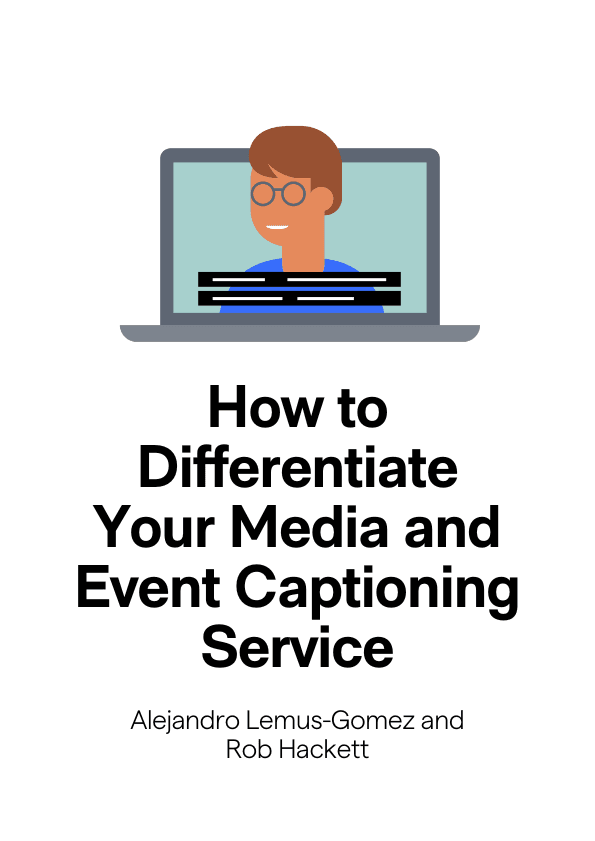- Blog
- How to Differentiate Your Media and Event Captioni...
Oct 18, 2022 | Read time 4 min
How to Differentiate Your Media and Event Captioning Service
Media and Event Captioning experts, Alejandro Lemus-Gomez and Rob Hackett, guide you through how speech-to-text can bring a return on your investment in Media and Event Captioning.
As the media landscape evolves and online content continues to increase, the role of the service provider in Captioning has never been more important. Or more lucrative. It’s our job to make sure you’re doing all you can to differentiate your Media and Event Captioning service from your competitors and give you the capability to thrive on this new stage.
But how is this possible in such a highly competitive market? What can you do to stand out from the crowd and offer the best service possible? Here are 4 ways we can help.
Serve a Global Audience
As content creators increasingly serve a global audience, captioning service providers must too. With providers like Netflix in over 190 countries and counting it’s no longer a case of UK and US-centric, English-led speech-to-text as the only goal worth aiming for. To that end we’ve recently increased the number of languages we offer by 14, so we now offer 50 languages. Adding more global language packs (with the ability to recognize and transcribe accents, dialects, and recognize context) means we now deliver higher accuracy to handle content from multiple demographics.
As the media world gets larger, we’ll do everything we can to help you tap into every market.
Improve Viewer Satisfaction
At Speechmatics, we believe accuracy is everything. Especially when it comes to improving viewer satisfaction. In addition to the 14 languages we’ve added, we’ve outperformed some of the biggest names in tech with our Enhanced model having been trained to a higher standard than Google across our new shared languages*. As mentioned above, the more places your captioning service can cater to, the more opportunities you’ll have access to. But that’s all moot if you’re not offering the best-in-class speech-to-text.
By choosing an engine with the best accuracy, it’s much less likely a competitor can come in and take your market position. If you’re at the back of the pack and wanting to move up, you’ll need a true differentiator like Speechmatics on your side to climb to where you want to be.
Stay Relevant
Earlier this year, we asked one of our Data Science Engineers to look into the evolution of online content and our constantly changing language. We dissected twenty-four different YouTube videos and compared providers to see who gave the best results for speech-to-text accuracy.
It wasn’t much of a surprise to us to find Speechmatics beating the competition to the number one spot. But the purpose of the Whitepaper – which you can read here – was more than just simply claiming victory. We wanted to show the importance of keeping on top of the changes in language and how aiming for continuously learning speech-to-text is essential for the future of speech recognition.
Reduce Risk
The increase of tighter rules and regulation around accessibility is another factor driving necessary change within the market of Media and Event Captioning. Fines for non-compliance due to lack of captioning (or poor-performing captions) can be crippling for commercial businesses that need a reliable and consistent output.
With so much at stake, do you really feel comfortable working with a second-tier provider? What is the reputational damage if a client is fined, and they can trace it back to you? Opting for the best-in-class reduces your risk and the media companies you serve at the same time.
Make the Right Move Today
At Speechmatics, we believe accuracy is the way to produce quality and efficiency in captioning, which is why we deliver best-in-class automatic speech-to-text at scale and at a low cost in as many languages as possible. Get in touch to learn how you can differentiate your caption service and stand out from the crowd.
Alejandro Lemus-Gomez and Rob Hackett – Media and Event Captioning Experts
Book a Meeting today with a Media and Event Captioning specialist and we’ll give you the tools you need to differentiate your Media and Event Captioning in the market and help you deliver on constantly evolving customer expectations.
*Speechmatics and Google have eight of the new languages in common: Basque, Estonian, Galician, Marathi, Mongolian, Tamil, Vietnamese, and Thai.